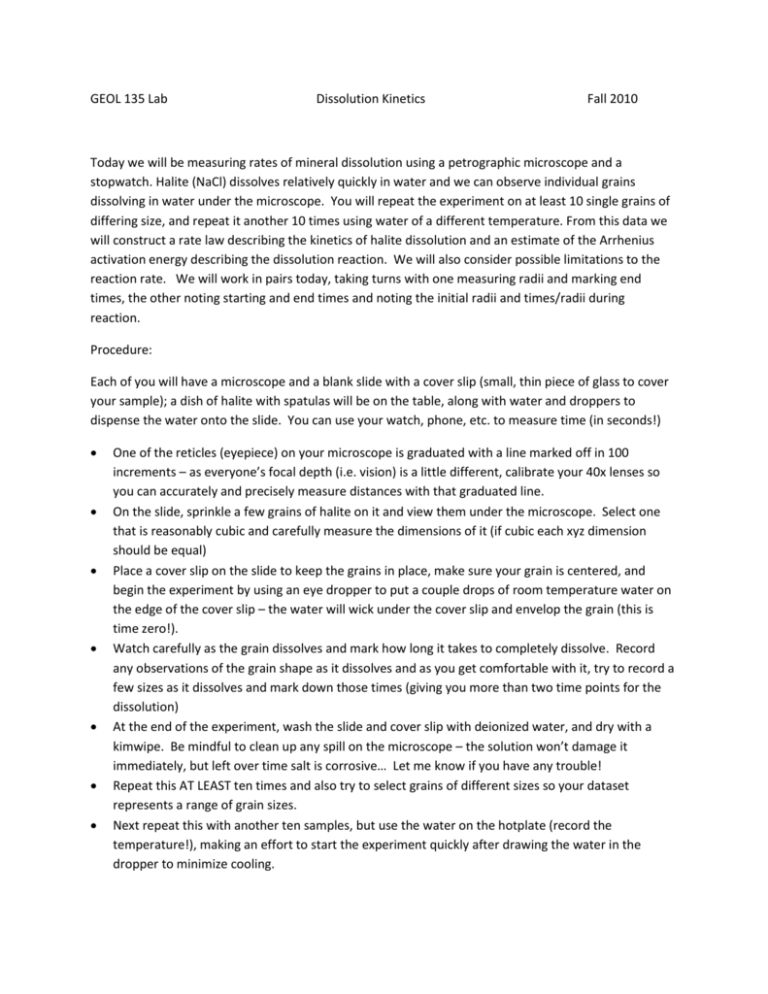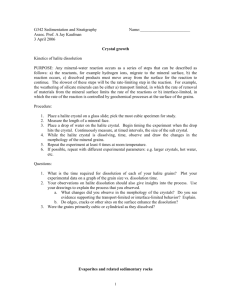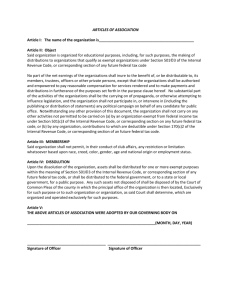Kinetics Lab - Halite dissolution
advertisement

GEOL 135 Lab Dissolution Kinetics Fall 2010 Today we will be measuring rates of mineral dissolution using a petrographic microscope and a stopwatch. Halite (NaCl) dissolves relatively quickly in water and we can observe individual grains dissolving in water under the microscope. You will repeat the experiment on at least 10 single grains of differing size, and repeat it another 10 times using water of a different temperature. From this data we will construct a rate law describing the kinetics of halite dissolution and an estimate of the Arrhenius activation energy describing the dissolution reaction. We will also consider possible limitations to the reaction rate. We will work in pairs today, taking turns with one measuring radii and marking end times, the other noting starting and end times and noting the initial radii and times/radii during reaction. Procedure: Each of you will have a microscope and a blank slide with a cover slip (small, thin piece of glass to cover your sample); a dish of halite with spatulas will be on the table, along with water and droppers to dispense the water onto the slide. You can use your watch, phone, etc. to measure time (in seconds!) One of the reticles (eyepiece) on your microscope is graduated with a line marked off in 100 increments – as everyone’s focal depth (i.e. vision) is a little different, calibrate your 40x lenses so you can accurately and precisely measure distances with that graduated line. On the slide, sprinkle a few grains of halite on it and view them under the microscope. Select one that is reasonably cubic and carefully measure the dimensions of it (if cubic each xyz dimension should be equal) Place a cover slip on the slide to keep the grains in place, make sure your grain is centered, and begin the experiment by using an eye dropper to put a couple drops of room temperature water on the edge of the cover slip – the water will wick under the cover slip and envelop the grain (this is time zero!). Watch carefully as the grain dissolves and mark how long it takes to completely dissolve. Record any observations of the grain shape as it dissolves and as you get comfortable with it, try to record a few sizes as it dissolves and mark down those times (giving you more than two time points for the dissolution) At the end of the experiment, wash the slide and cover slip with deionized water, and dry with a kimwipe. Be mindful to clean up any spill on the microscope – the solution won’t damage it immediately, but left over time salt is corrosive… Let me know if you have any trouble! Repeat this AT LEAST ten times and also try to select grains of different sizes so your dataset represents a range of grain sizes. Next repeat this with another ten samples, but use the water on the hotplate (record the temperature!), making an effort to start the experiment quickly after drawing the water in the dropper to minimize cooling. Data Manipulation: In excel, plot your data – initial radius (r0) vs. time to dissolve (td= tend-t0) and plot with td as the x-axis and r0 as the y axis. Add a linear best fit line to this and include the regression equation (in y=mx+b form) and the R2 value (1 is perfect fit, yours will be less…). Note that IF your data has a large enough range of sizes and measurements the data may be fit better by a curve, which we will address in the next part. For a linear approximation to this data we are assuming a zero-order kinetic rate law, such that: 𝑑𝑟 = −𝑘 𝑑𝑡 Where dr /dt is the derivative expression for how the radius changes in time (how fast does it shrink?), related only to an intrinsic rate constant, k (the negative sign indicates dissolution in this case, the radius is shrinking with reaction progress). Your plot should give a slope that you would get k from (in mm/second), note that this would be positive, but for dissolution the negative is contained in the rate law expression above. The intregration of this expression between t0 and any time is: 𝑟(𝑡) = 𝑟0 − 𝑘𝑡 If you were able to determine radii at times during the course of a dissolution experiment, note how close (or not!) radii through time are compared to the prediction we have generated thusfar. Now let’s investigate if the order of this reaction is really zero order. To do this, it is most useful to plot the log of the ‘instantaneous’ rate vs. the log of what may be controlling the rate – let’s try to plot log rate (the instantaneous rate) for each grain measured (r0/time); the slope in the log-log plot is equal now to the order of reaction… Next let’s determine the same set of things for your higher temperature data. Plot the k for each experiment vs. 1/T (in Kelvin!) – the slope of this line is equal to the activation energy for the reaction (having only 2 points this is not very well defined, but it is a start!) via the equation: 𝑙𝑜𝑔 𝑘1 𝐸𝐴 1 1 = [ − ] 𝑘2 2.303 𝑅 𝑇2 𝑇1 Where k1 and T1 refer to the constant and temperature for the room temperature experiments and K2 and T2 refer to the constant and temperature for the high temperature experiments. Lastly, we should consider what limits the rate of reaction we have measured – is it a reaction at the surface of the mineral where Na+ and Cl- go into solution, or is it limited by the diffusion of Na+ and Claway from the surface? To consider this we will quantify how rate may be limited by diffusion. For the theoretical calculation, we need to apply the equation: 𝑑𝑟 𝐷(𝐶𝑖𝑛𝑓 − 𝐶𝑒𝑞) = 𝑑𝑡 𝑟 Where D is the diffusion coefficient, Cinf is the concentration at infinite distance from the surface, Ceq is the equilibrium concentration of Na+ or Cl- in solution, r is radius, and t is time. D for Na+ is 1.33 x 10-5 cm2sec-1; D for Cl- is 2.03 x 10-5 cm2sec-1; Ceq can be determined from the equilibrium constant K (for the reaction NaCl = Na+ + Cl-, log K at 25 C is 1.5928) solved for equimolar Na+ and Cl- dissolution. Compare with the rate determined above (recall dr/dt = -k). For your report, analyze the data and determine the zero-order rate, and present the log-log information to assess specific order of the rate. Also calculate and graph data as a function of temperature and determine the Arrhenius activation energy. Calculate the diffusional rates based on both Na+ and Cl- diffusion rates and briefly discuss your evidence on what limits the rate of reaction at these conditions.







